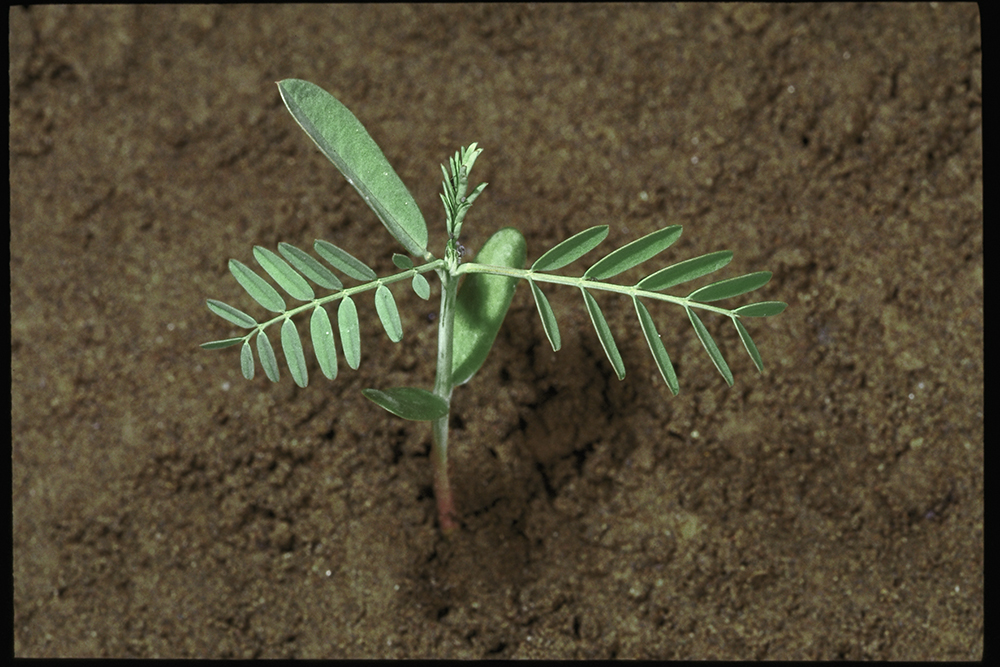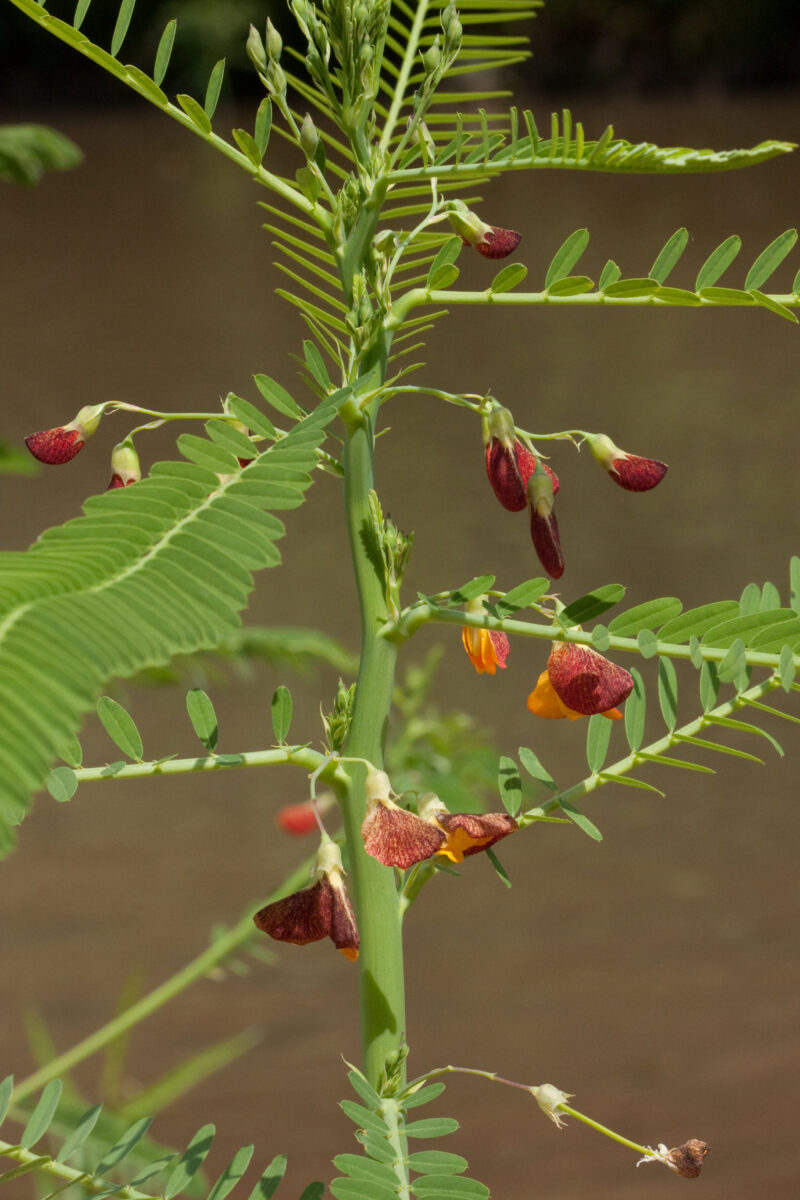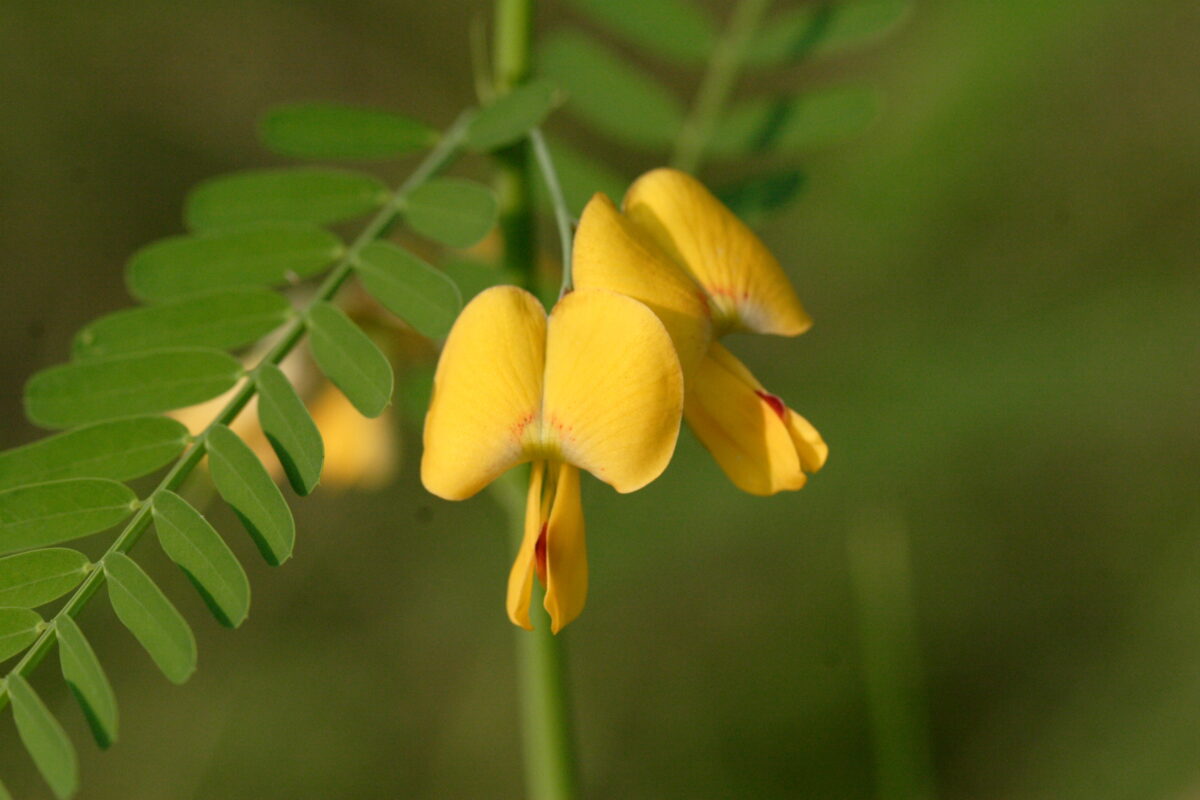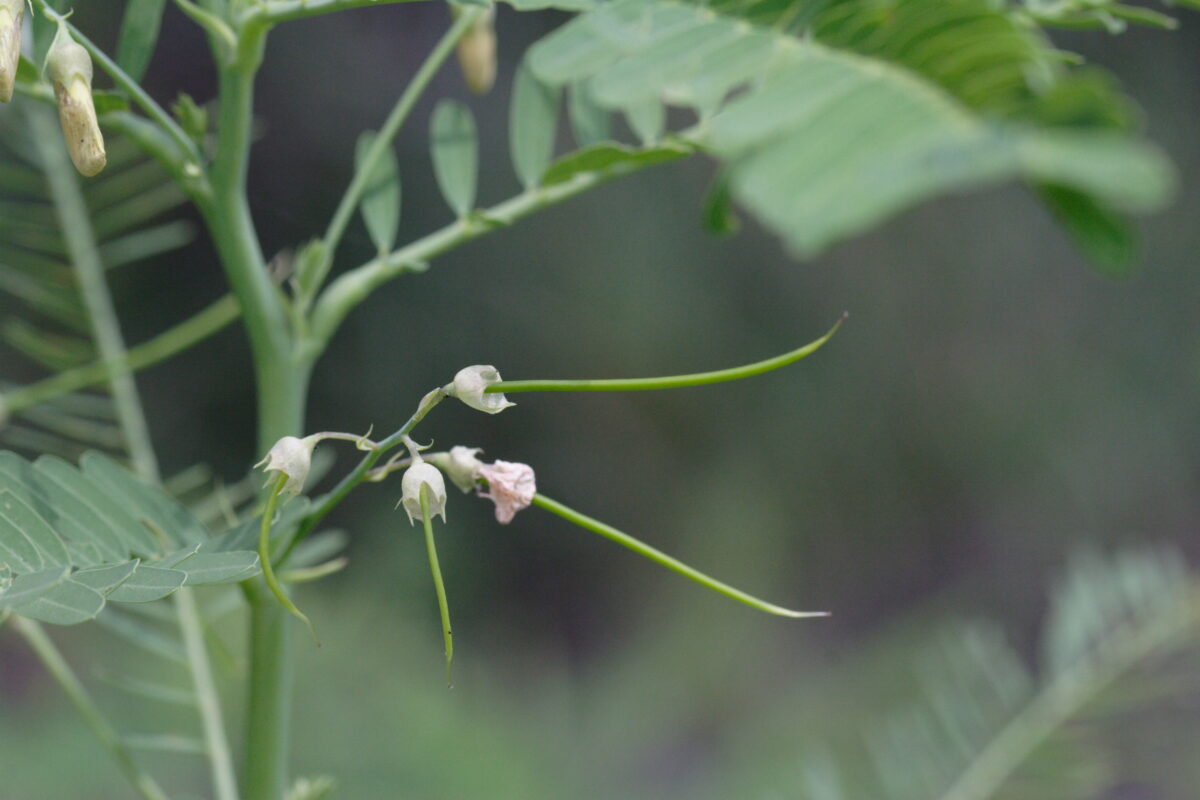Other common names: coffeeweed




Sesbania herbacea (Mill.) McVaugh = S. exaltata (Raf.) Rydb. ex A.W. Hill = S. macrocarpa Muhl. ex Raf.
Identification of Hemp Sesbania
Family: Legume family, Fabaceae
Habit: A tall, erect species, hemp sesbania behaves as an annual herb in most of the United States because it is killed by frost, but in perennially warm climates it is a semi-woody perennial.
Description: Cotyledons are fleshy, oblong to lanceolate, hairless and 0.4–1 inch long by 0.12–0.15 inch wide. The first true leaf of the seedling is simple, lanceolate and 0.8 inch long by 0.2 inch wide. All subsequent leaves are divided, with four to eight pairs of short-stalked, oppositely arranged, oblong to lanceolate leaflets with pointed tips. Young leaves are 0.8–2 inches long, while individual leaflets are 0.2–0.6 inch long by 0.06–0.12 inch wide. Leaf arrangement is alternate. Mature plants are typically 3–6 feet tall but occasionally reach over 10 feet, with smooth, green and generally unbranched stems that become woody with age. The leaves are fern-like, alternate, 4–12 inches long and divided into 20–70 oppositely arranged leaflets. Each leaflet is 0.75–2.5 inches long by 0.1–0.3 inch wide, hairless above and hairless to sparsely hairy below. Leaflet shape is similar to that of the seedling. The taproot is large and branched. The pea-like flowers occur in clusters of two to six on 0.7–3.8 inch-long stalks growing from the leaf axils. Flowers are yellow to yellow-orange, often spotted with purple and 0.4-0.6 inch long. Each flower is replaced by a four-sided, curved and jointed seedpod. The seedpods are 6–8 inches long by 0.1–0.2 inch wide with a 0.2–0.4 inch-long beak at the tip. Pods contain 30–40 seeds. Seeds are oblong, 0.1–0.3 inch long by 0.08–0.1 inch wide, glossy and solid brown to mottled tan and brown.
Similar species: Partridgepea [Chamaecrista fasciculata (Michx.) Greene] has similar foliage to hemp sesbania. Partridgepea leaves, however, have a distinctive orange gland at the base and have fewer leaflets (16–30) than those of hemp sesbania.
Management of Hemp Sesbania
Hemp sesbania is an important weed of rice and summer row crops. However, because its diffuse canopy of small leaflets allows passage of light and the profusion of N-fixing nodules on its root system minimize competition for N with the crop, this weed is often less competitive than its rapid growth and great stature would indicate.
Hemp sesbania grows best at hot, mid-summer day/night temperatures of 86/77°F or above. Soybean growth is slowed less by cooler, 77/59°F day/night temperatures, than hemp sesbania. Hence, establishing soybeans relatively early in the growing season helps give the crop a competitive head start. Similarly, corn and spring cereals that can germinate and grow at cooler temperatures than are suitable for hemp sesbania can competitively suppress this species. Since the seeds survive well in undisturbed soil, rotation with sod crops like alfalfa will only moderately reduce the seed bank.
Since some hemp sesbania seedlings will emerge from below crop planting depths, tine weeders and rotary hoes are only partially effective. Cultivate shallowly close to the row. Plants do not usually emerge above the soybean canopy until late July or early August, but most competition occurs four to 10 weeks after soybean emergence. Nevertheless, if possible, mow off plants just above the crop canopy shortly after the weed begins to flower to reduce seed production. The tall height, tough stems and superficial root system probably make this weed susceptible to mechanical weed pullers in soybeans, cotton and some other crops. Yield loss in soybeans can be reduced by high crop density (e.g., 209,000 plants per acre). High density planting in rice probably will also help suppress the weed. Irrigation of soybeans with unmanaged hemp sesbania in Arkansas increased growth and light interception by the weed at the expense of the crop but still substantially increased crop yield.
Since hemp sesbania supports nitrogen fixing symbiotic bacteria, it is relatively independent of soil N for growth. Hence any N deficiency will competitively favor this weed over the crop. It produces root exudates that inhibit soybean nodulation, so N fertilization sometimes helps soybeans compete with this weed.
Ecology of Hemp Sesbania
Origin and distribution: Hemp sesbania is native to the Southeast, southern Midwest and southwest United States; it occurs south to Central America and sporadically northward to southern Ontario. It has been introduced into Russia.
Seed weight: Population mean seed weights range from 6–15 mg.
Dormancy and germination: Hemp sesbania seeds have physical dormancy maintained by an impermeable seed coat and at maturity, few seeds will germinate. Permeable seeds germinate well at temperatures from 58–104°F, but germination is negligible at 41°F. Light neither promotes nor inhibits germination. Seeds have to take up 58–65% of their weight in water to germinate, and two or more cycles of partial hydration followed by dehydration greatly decrease germinability, probably by killing the seeds. However, seeds will germinate under greater moisture stress than soybeans.
Seed longevity: Hemp sesbania seeds persist well in the soil seed bank, with 18% surviving 5.5 years of undisturbed burial, resulting in a computed 27% annual rate of mortality per year. Nevertheless, when a hemp sesbania seed bank was tilled annually to depths of 2–6 inches, emergence declined by an average of 65% per year over a four-year period, with slightly faster declines with deeper tillage. Overwinter flooding of fields causes only minor deterioration of seeds.
Season of emergence: In a study in Mississippi, seedlings emerged primarily from May through July, with often two distinct periods of emergence. A series of soybean experiments planted mid-May to early June found that most hemp sesbania emerged simultaneously with the crop, and in another experiment 98% of seeds emerged within a six-week period.
Emergence depth: Hemp sesbania emerges best from 0.4–1.2 inch, but a few seedlings can emerge from depths up to 5 inches. Under favorable conditions, seeds in the top 1.2 inch of soil can emerge in as little as two days, giving the weed a head start over many crops.
Photosynthetic pathway: C3
Sensitivity to frost: Hemp sesbania does not tolerate frost.
Drought tolerance: The species grows best in moist conditions but can tolerate drought once it is well established.
Mycorrhiza: Hemp sesbania is mycorrhizal.
Response to fertility: Hemp sesbania roots form an association with nitrogen fixing rhizobial bacteria and are not responsive to N fertility. It tolerates pH down to 4.5 and also tolerates alkaline conditions.
Soil physical requirements: Hemp sesbania is most troublesome on clay and heavy loam soils, and it grows poorly on sandy soils. Hemp sesbania tolerates flooding and waterlogged soils, so it can be a problem in both rainfed and paddy rice conditions. It also tolerates salinity and has been used as a green manure for reclaiming saline soils.
Response to shade: It is highly intolerant of shade, but if given the opportunity, it grows 10 feet or more in height and thus can potentially overtop the tallest of crops.
Sensitivity to disturbance: Killing plants at initial pod set, defined as 75% blossom drop when pods were less than 3 inches, reduced production of viable seeds by 94%.
Time from emergence to flowering: Plants flower from June to October, with flowers appearing about six to seven weeks after emergence. The time from initial pod set to seed maturity is about six weeks. Thus, plants emerging in May mature by mid-August. In California, seed production continues from June to October, but seed production from a given flush of emergence occurs more or less simultaneously.
Pollination: Flowers are visited by bees but, as with related species, may be self pollinated as well.
Reproduction: Widely spaced plants produced 21,500 seeds per plant. Plants spaced 3 feet produced 2,100–9,400 seeds per plant.
Dispersal: Legume seeds with hard seed coats survive digestion in cattle, so many seeds that are eaten are likely to disperse in feces or when manure is spread. Seeds tolerate flooding well and probably move in flood water. The seeds can contaminate crop seed and may occasionally be dispersed during disposal of cotton gin trash.
Common natural enemies: The anthracnose fungi Colletotrichum truncatum is being developed as a biocontrol agent.
Palatability: Hemp sesbania has better digestibility and higher crude protein than common southern forage grasses but has a higher than optimal Ca:P ratio after flowering. Although other species of Sesbania cause irritation of the digestive tract and diarrhea in domestic animals, hemp sesbania has low toxicity. Nevertheless, 2–3% hemp sesbania seeds in the diet of chickens will reduce food intake and egg production, and 7% creates low level mortality.
Summary Table of Hemp Sesbania Characteristics
| Hemp sesbania | ||||||||
|---|---|---|---|---|---|---|---|---|
| Growth habit | Seed weight (mg) | Seed dormancy at shedding | Factors breaking dormancy | Optimum temperature for germination (F) | Seed mortality in untilled soil (%/year) | Seed mortality in tilled soil (%/year) | Typical emergence season | Optimum emergence depth (inches) |
| tall, erect | 6–15 | Yes | scd | 58–104 | 27 | 65 | mid-spring to summer | 0.4–1.2 |
| Photosynthesis type | Frost tolerance | Drought tolerance | Mycorrhiza | Response to nutrients | Emergence to flowering (weeks) | Flowering to viable seed (weeks) | Pollination | Typical & high seed production (seeds per plant) |
| C3 | low | moderate | yes | low | 6–7 | 6 | both | 2,000 & 20,000 |
Table Key
General: The designation “–” signifies that data is not available or the category is not applicable.
Growth habit: A two-word description; the first word indicates relative height (tall, medium, short, prostrate) and second word indicates degree of branching (erect, branching, vining).
Seed weight: Range of reported values in units of “mg per seed.”
Seed dormancy at shedding: “Yes” if most seeds are dormant when shed, “Variable” if dormancy is highly variable, “No” if most seeds are not dormant.
Factors breaking dormancy: The principle factors that are reported to break dormancy and facilitate germination. The order of listing does not imply order of importance. Abbreviations are:
scd = seed coat deterioration
cms = a period subjected to cold, moist soil conditions
wst = warm soil temperatures
li = light
at = alternating day-night temperatures
ni = nitrates
Optimum temperature range for germination: Temperature (Fahrenheit) range that provides for optimum germination of non-dormant seeds. Germination at lower percentages can occur outside of this range. The dash refers to temperature range, and the slash refers to alternating day/night temperature amplitudes.
Seed mortality in untilled soil: Range of mortality estimates (percentage of seed mortality in one year) for buried seeds in untilled soil. Values were chosen where possible for seeds placed at depths below the emergence depth for the species and left undisturbed until assessment. Mortality primarily represents seed deterioration in soil.
Seed mortality in tilled soil: Range of mortality estimates (percentage of seed mortality in one year) for seeds in tilled soil. Values were chosen for seeds placed within the tillage depth and subjected to at least annual tillage events. Seed losses are the result of dormancy-breaking cues induced by tillage, germination and deterioration of un-germinated seeds.
Typical emergence season: Time of year when most emergence occurs in the typical regions of occurrence for each weed. Some emergence may occur outside of this range.
Optimum emergence depth: Soil depths (in inches below the soil surface) from which most seedlings emerge. Lower rates of emergence usually will occur at depths just above or just below this range.
Photosynthesis type: Codes “C3” or “C4” refer to the metabolic pathway for fixing carbon dioxide during photosynthesis. Generally, C3 plants function better in cooler seasons or environments and C4 plants function better in warmer seasons or environments.
Frost tolerance: Relative tolerance of plants to freezing temperatures (high, moderate, low).
Drought tolerance: Relative tolerance of plants to drought (high, moderate, low).
Mycorrhiza: Presence of mycorrhizal fungi. “Yes” if present; “no” if documented not to be present, “unclear” if there are reports of both presence and absence; “variable” if the weed can function either with or without, depending on the soil environment.
Response to nutrients: Relative plant growth response to the nutrient content of soil, primarily N, P, K (high, moderate, low).
Emergence to flowering: Length of time (weeks) after emergence for plants to begin flowering given typical emergence in the region of occurrence. For species emerging in fall, “emergence to flowering” means time from resumption of growth in spring to first flowering.
Flowering to viable seed: Length of time (weeks) after flowering for seeds to become viable.
Pollination: “Self” refers to species that exclusively self-pollinate, “cross” refers to species that exclusively cross-pollinate, “self, can cross” refer to species that primarily self-pollinate, but also cross-pollinate at a low rate, and “both” refers to species that both self-pollinate and cross-pollinate at relatively similar rates.
Typical and high seed production potential: The first value is seed production (seeds per plant) under typical conditions with crop and weed competition. The second value, high seed production, refers to conditions of low density without crop competition. Numbers are rounded off to a magnitude that is representative of often highly variable reported values.
Further Reading
Lovelace, M.L. and L.R. Oliver. 2000. Effects of interference and tillage on hemp sesbania and pitted morningglory emergence, growth, and seed production. 2000. Proceedings of the Southern Weed Science Society 53: 202.
Norsworthy, J.K. and L.R. Oliver. 2002b. Effect of irrigation, soybean (Glycine max) density and glyphosate on hemp sesbania (Sesbania exaltata) and pitted morningglory (Ipomoea lacunosa). Weed Technology 16: 7–17.
Woon, C.K. 1987. Effect of two row spacings and hemp sesbania competition on sunflower. Journal of Agronomy and Crop Science 159: 15–20.

